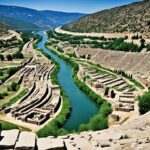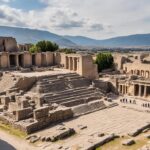Jericho is a city of immense biblical significance, mentioned in the Old Testament as the city where the Israelites witnessed the miraculous collapse of its walls. However, the history of Jericho extends far beyond these iconic events. This ancient city has a rich historical and religious legacy that predates the biblical accounts.
Located in the Jordan Rift Valley, Jericho was one of the oldest inhabited cities in the world, witnessing the rise and fall of civilizations for thousands of years. Its geographical position near the Jordan River and the Dead Sea made it a strategic crossroads for trade and travel. Jericho’s fertile plain, blessed with freshwater springs and an abundance of palm trees, earned it the epithet “the city of palm trees.”
Archaeological excavations conducted in Jericho have unveiled remarkable discoveries. Walls, defensive towers, and other structures have been unearthed, corroborating the biblical narrative and shedding light on the lives of its ancient inhabitants. These findings provide a tangible connection to the past and offer valuable insights into the cultural and religious practices of the time.
The story of Jericho is not merely one of historical significance — it carries profound theological themes of faith and triumph. The Israelites demonstrated unwavering faith by following God’s instructions to march around the city, leading to the collapse of its walls. This victory symbolizes the power of faith and the fulfillment of God’s promises.
While the historicity of Jericho has been the subject of academic debate, the archaeological evidence, including the destruction of the walls and other elements described in the biblical account, supports the authenticity of the narratives found in the Old Testament.
Join us as we embark on a journey to explore the biblical significance, historical context, and spiritual meaning of Jericho, uncovering the ancient secrets that have captivated scholars and believers for centuries.
Key Takeaways:
- Jericho is a city of immense biblical significance mentioned in the Old Testament.
- It holds historical importance as one of the oldest inhabited cities in the world.
- Located in the Jordan Rift Valley, Jericho offered strategic trade and travel opportunities.
- Archaeological excavations have revealed walls, defensive towers, and cultural artifacts.
- The story of Jericho carries theological themes of faith and triumph.
Historical Significance of Jericho
Jericho holds immense historical significance as one of the oldest cities ever built by humans. Archaeological discoveries in Jericho have provided valuable insights into the lives of its ancient inhabitants. Excavations conducted by renowned archaeologists such as Charles Warren, Kathleen Kenyon, and Lorenzo Nigro have unearthed the city’s ancient walls and other structures.
These archaeological findings align with the biblical account of Jericho, further amplifying its historical importance. The discovery of the collapsed walls reflects the ancient city’s unique story and adds a layer of authenticity to its historical significance.
Jericho’s ancient walls stand as a testament to the city’s enduring legacy. Through meticulous excavation and analysis, archaeologists have been able to reconstruct the layout and design of these walls, shedding light on the architectural prowess of the ancient Jerichoites.
“The archaeological discoveries in Jericho have revealed fascinating insights into the past, showcasing the ingenuity and resilience of its ancient inhabitants.” – Archaeologist Charles Warren
By studying the archaeological remains in Jericho, experts have gained valuable knowledge about the daily lives, customs, and culture of the ancient Jerichoites. These discoveries enrich our understanding of the historical context in which the city thrived, allowing us to connect with the past in a profound way.
Archaeological Discoveries in Jericho
The table below outlines some of the notable archaeological discoveries made in Jericho:
| Excavation | Discoveries |
|---|---|
| Charles Warren’s Excavation | Ancient walls and structures |
| Kathleen Kenyon’s Excavation | Remains of the Neolithic settlement |
| Lorenzo Nigro’s Excavation | Signs of a thriving Bronze Age city |
These archaeological discoveries provide tangible evidence of the historical significance and ancient origins of Jericho. They help paint a vivid picture of the city’s past, allowing us to appreciate its cultural, architectural, and historical significance.
Geographical Location of Jericho
Jericho, an ancient city of great historical and religious significance, is strategically located in the Jordan Rift Valley. Situated approximately 6 miles from the Jordan River and 7.5 miles northwest of the Dead Sea, Jericho’s geographical position made it a vital crossroads for trade and travel during ancient times. Blessed with a fertile plain and abundant freshwater springs, the city acquired the nickname “the city of palm trees.”
Archaeological Discoveries in Jericho
The excavations conducted in Jericho have revealed remarkable archaeological discoveries, shedding light on the ancient city’s historical past. Pioneering excavations led by Charles Warren unveiled portions of the renowned Temple Mount, a significant religious site. Warren’s Shaft, a meticulously engineered water shaft providing vital access to water, was also unearthed during these excavations.
In subsequent expeditions, notable archaeologists such as Ernst Sellin, Carl Watzinger, and Kathleen Kenyon pursued further investigations, unearthing additional remnants of the ancient city of Jericho. These excavations were instrumental in uncovering defensive towers, corroborating the city’s fortified nature. The extensive findings emphasized the strategic significance of Jericho as a well-situated settlement with natural defenses and abundant water supply.
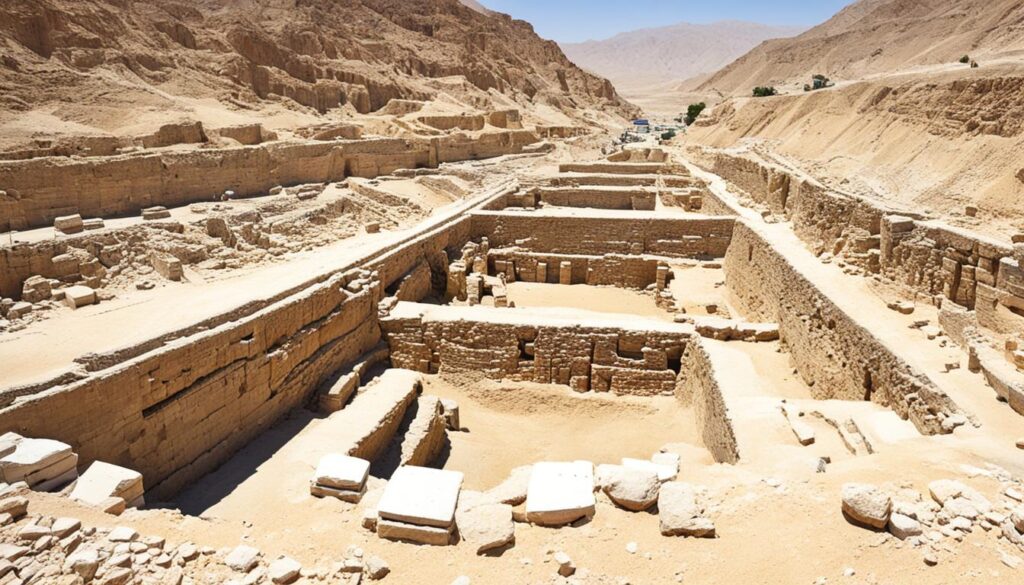
Temple Mount and Warren’s Shaft
The first significant archaeological findings in Jericho were the Temple Mount and Warren’s Shaft. These discoveries provided valuable insights into the religious and water systems of the ancient city. The Temple Mount served as a sacred site, central to the religious practices of the inhabitants, while Warren’s Shaft demonstrated their advanced engineering capabilities to access water sources.
Defensive Towers and Settlement Layout
Subsequent excavations revealed the existence of defensive towers within the city walls, highlighting the importance of safeguarding the residents and their assets. These towers attest to the defensive strategies employed by the ancient Jericho residents. The excavations also uncovered evidence of a well-planned settlement layout, emphasizing the city’s strategic positioning and successful utilization of its natural resources.
Key Archaeological Discoveries
| Excavation | Discoveries |
|---|---|
| Charles Warren | Temple Mount, Warren’s Shaft |
| Kathleen Kenyon | Defensive towers, well-planned settlement layout |
| Ernst Sellin | N/A |
| Carl Watzinger | N/A |
These archaeological discoveries have played a crucial role in unraveling the mysteries of Jericho’s history and enriching our understanding of the ancient city. They provide valuable clues about the lives, culture, and fortification strategies of its inhabitants, giving us a glimpse into the distant past.
Theological Themes in Jericho
The story of Jericho in the Bible encompasses powerful theological themes of faith and triumph. It recounts the remarkable demonstration of faith by the Israelites as they obediently followed God’s instructions to march around the city walls and blow their trumpets. Miraculously, their unwavering faith resulted in the walls of Jericho collapsing, paving the way for victory and the fulfillment of God’s promises.
“By faith the walls of Jericho fell, after the army had marched around them for seven days.” – Hebrews 11:30
This biblical account of Jericho carries profound significance, highlighting the transformative power of faith. It serves as a reminder that through trust in God and unwavering belief in His promises, even the most formidable obstacles can be overcome. The theme of faith and triumph resonates throughout the story of Jericho, inspiring believers to remain steadfast in their trust in God, knowing that He is able to bring down walls and bring about victory in any situation.
Furthermore, the triumph at Jericho holds a profound biblical significance. It serves as a testament to God’s faithfulness, unchanging nature, and ability to accomplish the impossible. The victory at Jericho foreshadows the triumph of God’s people over their enemies and serves as a sign of hope for believers, reassuring them that God is with them in their battles and will secure their ultimate victory.
By exploring the theological themes present in the account of Jericho, individuals are encouraged to deepen their faith, cultivate unwavering trust in God, and understand the biblical significance of this historic event. The story of Jericho serves as a source of inspiration and encouragement for believers, reminding them of the power of faith and ultimately pointing them towards the divine triumph that awaits.
Key Takeaways:
- The story of Jericho showcases theological themes of faith and triumph.
- By following God’s instructions, the Israelites witnessed the walls of Jericho collapse in an incredible display of faith.
- This triumphant event underscores the transformative power of unwavering trust in God.
- Jericho holds great biblical significance, signifying God’s faithfulness and the ultimate victory of His people.
- Exploring these theological themes deepens faith, encourages believers, and highlights the significance of Jericho in biblical narratives.
Key Biblical Events in Jericho
The Battle of Jericho, led by Joshua, stands out as a key biblical event associated with the city. According to the Old Testament, the Israelites, under Joshua’s command, conquered and destroyed Jericho in obedience to God’s instructions. This victorious battle marked the beginning of the Israelites’ conquest of the Promised Land.
The destruction of Jericho holds immense significance in biblical history, capturing the attention of scholars and theologians for centuries. The account of the crumbling walls and the Israelites’ triumph over the city has been widely studied and debated, exploring its theological and historical implications.
“And the walls of Jericho fell down flat, so that the people went up into the city, every man straight before him, and they took the city.” – Book of Joshua
The Battle of Jericho embodies themes of faith, obedience, and divine intervention. The Israelites exemplified unwavering faith as they followed God’s unconventional plan of marching around the city and blowing their trumpets, leading to its ultimate destruction.
This key biblical event in Jericho’s history serves as a reminder of the power of faith and God’s fulfillment of His promises to His people.

Through archaeological discoveries and biblical narratives, the story of Jericho and its key events continue to captivate believers and historians alike, weaving together the rich tapestry of human history and divine intervention.
Cultural and Religious Practices in Jericho
Jericho has a rich history of cultural and religious practices. One of the earliest settled cultures in the region was the Natufian culture, which thrived in the area from around 12,600 to 10,000 BCE. These ancient inhabitants of Jericho lived a semi-sedentary lifestyle and were among the first to establish settlements in the city.
The cultural practices in Jericho provide valuable insights into the beliefs and rituals of the Natufian culture. One notable example is the discovery of plastered skulls, which indicate a form of ancestor veneration or ritualistic practices. These plastered skulls were meticulously crafted and likely held significant spiritual or cultural significance for the community. Burial customs, such as specific grave goods or burial positions, also shed light on the religious practices and beliefs of the ancient Jericho inhabitants.
“The cultural practices in Jericho offer a glimpse into the spiritual and social lives of the people who once called this ancient city home. The plastered skulls and burial customs provide fascinating clues about their beliefs and rituals.”
Further archaeological excavations and studies continue to deepen our understanding of the cultural and religious practices in Jericho. The exploration of ancient artifacts, structures, and burial sites provides a window into the past, allowing us to appreciate the diverse and complex heritage of this historic city.
| Key Aspects of Cultural and Religious Practices in Jericho |
|---|
| Plastered Skulls |
| Burial Customs |
| Ancestor Veneration |
| Ritualistic Practices |
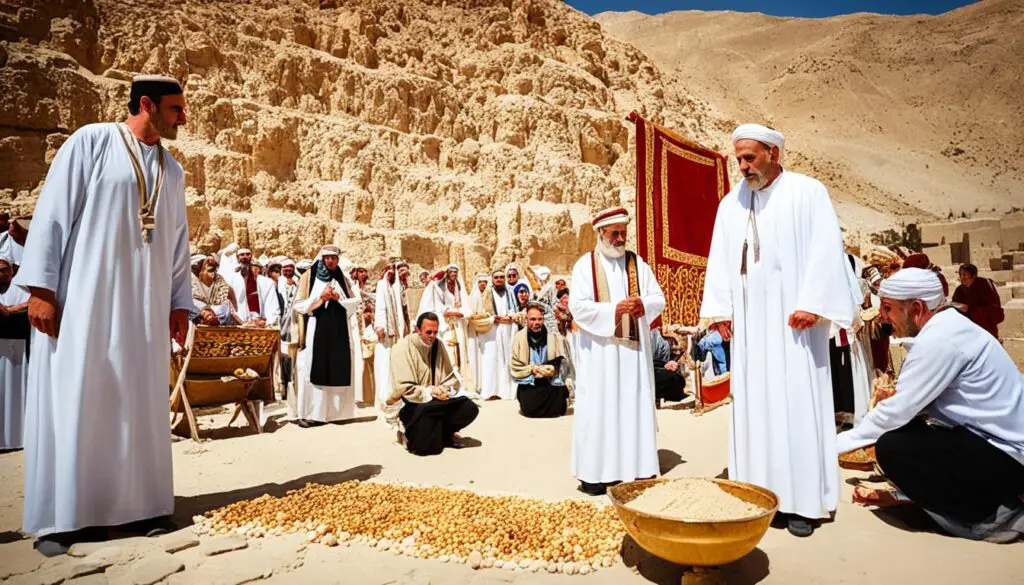
Prophetic and Eschatological Significance of Jericho
Jericho holds profound prophetic and eschatological significance in the Bible. This ancient city is mentioned in various biblical prophecies, shedding light on its spiritual and symbolic meaning. One such prophecy can be found in the book of Zechariah, where the restoration of Jericho is foretold.
The prophetic significance of Jericho stems from its association with the final days and the return of Christ. The city’s historical and biblical importance amplifies its role in fulfilling divine prophecies. As believers delve into the prophetic texts, the prophetic threads woven around Jericho foster a deeper understanding of biblical narratives and the unfolding of God’s plan.
“And it shall come to pass in that day, that I will seek to destroy all the nations that come against Jerusalem. And I will pour upon the house of David, and upon the inhabitants of Jerusalem, the spirit of grace and of supplications: and they shall look upon me whom they have pierced, and they shall mourn for him, as one mourneth for his only son, and shall be in bitterness for him, as one that is in bitterness for his firstborn.”
– Zechariah 12:9-10
Through biblical prophecies, Jericho’s eschatological significance intertwines with expectations of great spiritual awakening and the ultimate fulfillment of God’s plan. Its inclusion in prophetic texts underscores the enduring impact of this ancient city and its connection to the divine.
Connections Between Jericho and Biblical Prophecies
| Biblical Prophecy | Significance of Jericho |
|---|---|
| The restoration of Jericho (Zechariah 1:16-17) | Jericho’s ultimate resurrection and renewal in the fulfillment of divine promises. |
| The day of the Lord’s vengeance (Jeremiah 46:10) | Jericho serves as a prophetic marker of God’s judgment and the ultimate triumph of righteousness. |
| The fulfillment of Davidic promises (Isaiah 9:7) | Jericho’s restoration aligns with the Messianic prophecies and the establishment of everlasting peace. |
As believers explore the prophetic and eschatological significance of Jericho, they gain insights into the grand tapestry of biblical prophecies and their imminent fulfillment. Through the lens of Jericho, we glimpse the transcendent power of God’s promises and the eschatological hope that awaits us all.
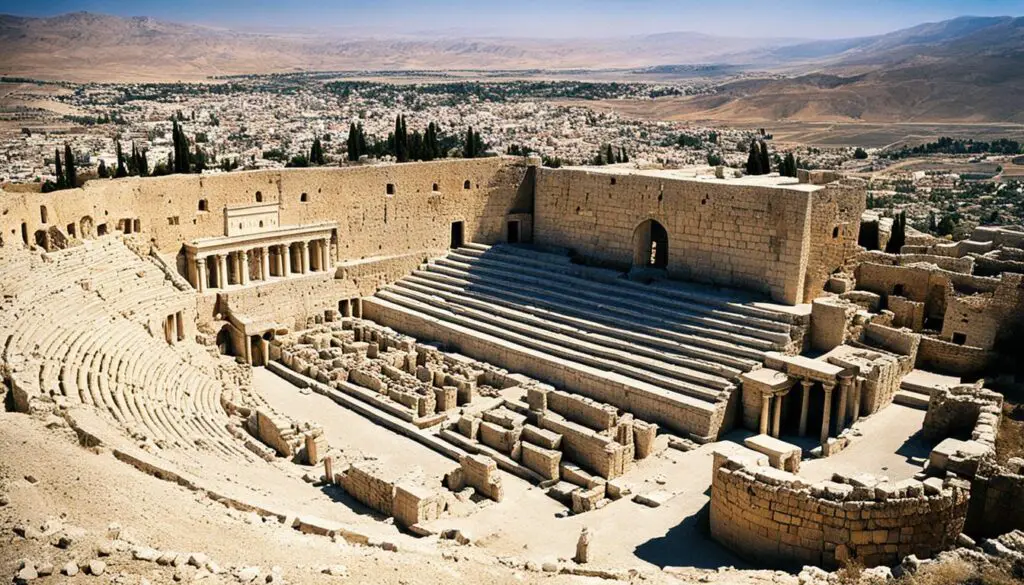
The Debate on Jericho’s Historicity
The historicity of Jericho has long been a subject of debate among scholars, with differing interpretations of the archaeological evidence and its correlation to the biblical account. One notable figure in this debate is Kathleen Kenyon, whose findings initially challenged the accuracy of the biblical narrative.
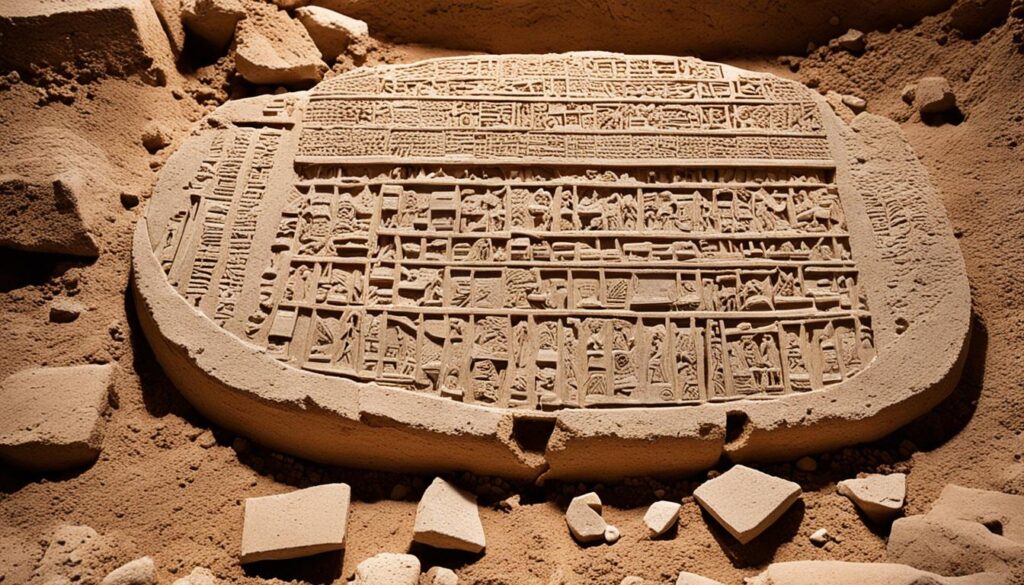
“Jericho is one of the most extensively excavated sites in the Levant, and its rich archaeological record provides valuable insights into the ancient history of this region. However, some scholars, like Kathleen Kenyon, have raised doubts about the reliability of the biblical account of Jericho’s destruction.”
Kenyon’s excavation in the 1950s revealed an earlier destruction layer beneath the commonly associated timeframe of Joshua’s conquest. Based on her findings, she proposed that the walls of Jericho had collapsed prior to the Israelites’ arrival, possibly due to an earthquake, thus contradicting the biblical account in the Book of Joshua.
In contrast, archaeologist Bryant Wood later re-examined the evidence and presented an alternative interpretation that supports the historicity of Jericho as described in the Bible. Wood’s analysis suggests that Kenyon’s dating of the destruction layer was inaccurate, and that the collapsed walls actually align with the biblical narrative.
“Wood’s research indicates that the walls of Jericho indeed experienced a catastrophic collapse, which can be attributed to the Israelite conquest described in the Book of Joshua. His findings shed new light on the historical validity of the biblical account.”
The archaeological evidence, including the presence of burnt grain samples and a sudden destruction layer, supports the biblical narrative of Joshua’s conquest and the subsequent destruction of Jericho’s walls. Although the debate on Jericho’s historicity is ongoing, Wood’s re-examination brings into question some of the previous conclusions and highlights the complexities of interpreting archaeological findings in relation to biblical accounts.
Ultimately, the historicity of Jericho and its significance in both history and biblical literature continue to fascinate scholars and enthusiasts alike. The ongoing exploration and analysis of archaeological evidence provide valuable insights into the ancient world and its connection to the biblical account.
Conclusion
Jericho in the Bible holds immense historical and religious significance. Through its archaeological discoveries, geographical location, and biblical narratives, we gain a deeper understanding of this ancient city. The debate surrounding Jericho’s historicity highlights the complex relationship between archaeology and biblical interpretation. Despite differing opinions, Jericho remains a focal point for studying the intersection of history, faith, and culture in the ancient world.
FAQ
What is the biblical significance of Jericho?
What is the historical significance of Jericho?
Where is Jericho located geographically?
What archaeological discoveries have been made in Jericho?
What theological themes are associated with Jericho?
What are the key biblical events associated with Jericho?
What cultural and religious practices were present in Jericho?
What is the prophetic and eschatological significance of Jericho?
What is the debate on Jericho’s historicity?
Source Links
- https://www.thecollector.com/jericho-ancient-city-secrets/
- https://biblearchaeology.org/research/conquest-of-canaan/3865-jericho-does-the-evidence-disprove-or-prove-the-bible
- https://www.biblearchaeology.org/research/conquest-of-canaan/4145-secrets-of-the-bible-the-fall-of-jericho-with-dr-bryant-wood





